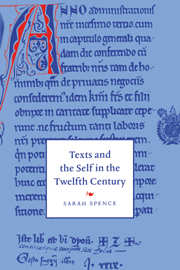Book contents
- Frontmatter
- Contents
- Acknowledgements
- 1 Corpus, body, text (and self)
- 2 Writing out the body: Abbot Suger, De administratione
- 3 Text of the body: Abelard and Guibert de Nogent
- 4 Text of the self: Guilhem IX and Jaufre Rudel, Bernart de Ventadorn and Raimbaut d'Aurenga
- 5 Writing in the vernacular: the Lais of Marie de France
- 6 Conclusion
- Works cited
- Index
- Cambridge Studies in Medieval Literature
5 - Writing in the vernacular: the Lais of Marie de France
Published online by Cambridge University Press: 08 January 2010
- Frontmatter
- Contents
- Acknowledgements
- 1 Corpus, body, text (and self)
- 2 Writing out the body: Abbot Suger, De administratione
- 3 Text of the body: Abelard and Guibert de Nogent
- 4 Text of the self: Guilhem IX and Jaufre Rudel, Bernart de Ventadorn and Raimbaut d'Aurenga
- 5 Writing in the vernacular: the Lais of Marie de France
- 6 Conclusion
- Works cited
- Index
- Cambridge Studies in Medieval Literature
Summary
It has long been argued that the world as it is presented in the Lais of Marie de France is more textual than real, more semiotic than mimetic. Robert Sturges speaks of the “purely textual” quality of Marie's works, while Brewster Fitz speaks of them as a “purely linguistic experience.” Such an approach, however, tends to obscure the importance Marie grants to the visual, tangible world. It is my argument, rather, that the Lais offer a textual system in which the text is presented as an object in the world and, as a result, the world takes on a power that it was specifically denied in the works studied so far. The association of text and self is now perceived in terms of their interaction with reality. As a result, the Lais of Marie de France offer a new way of reading that speaks to the existence of a self that, like the vernacular text, is rooted in the body but distinct from it.
In the 56-line Prologue to the Lais, Marie draws a distinction between her own approach, which is to dispense with silence and secrecy, (“Ne se deit taisir ne celer, / Ains se deit voluntiers mustrer,” lines 3–4) and that of the anciens who, as “Priscian” testifies, speak obscurely (oscurement), requiring the reader to “gloser la lettre e de lur sen la surplus mettre.” Marie provides justifications for both sides.
- Type
- Chapter
- Information
- Texts and the Self in the Twelfth Century , pp. 119 - 140Publisher: Cambridge University PressPrint publication year: 1996



